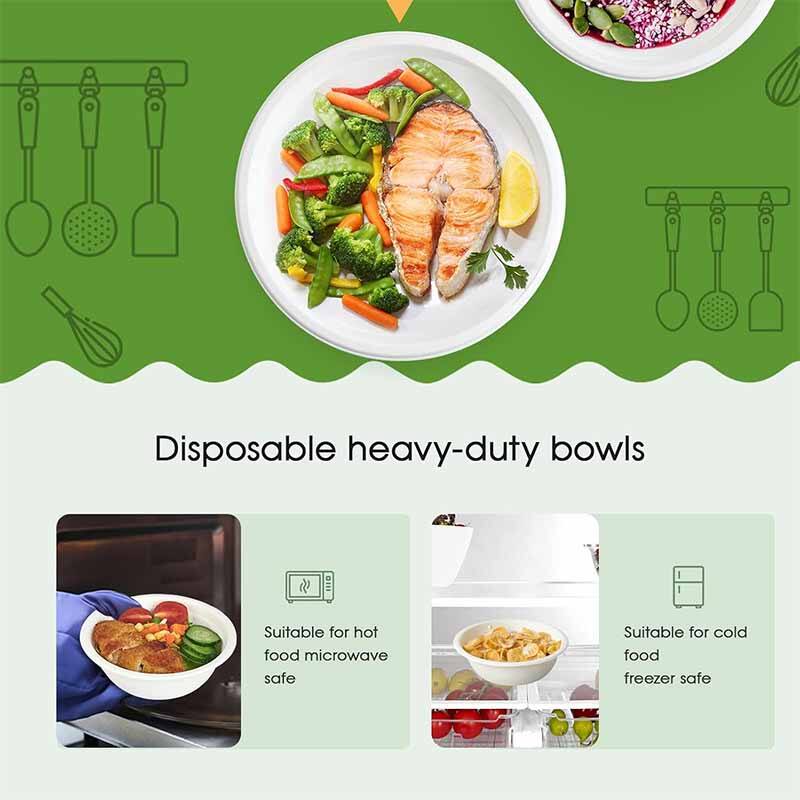Common Materials Used in Natural Fiber Food Containers: Bagasse, Bamboo Fiber, and Molded Pulp
Most natural fiber food containers come from three main sources: bagasse, which is basically leftover sugarcane stuff, bamboo fibers, and molded pulp made from recycled paper or cardboard. The raw materials all come from plants rich in cellulose. For instance, sugarcane bagasse has around 46% cellulose plus about 24.5% hemicellulose according to recent research by Chen and colleagues. Bamboo stands out because it contains more lignin, sometimes as much as 22.4%, making these containers sturdier for things like takeout boxes and plates. This extra strength helps them hold up better when carrying hot meals or greasy foods without falling apart.
| Material | Cellulose (%) | Hemicellulose (%) | Lignin (%) | Use Case |
|---|---|---|---|---|
| Sugarcane Bagasse | 46 | 24.5 | 19.5 | Clamshell containers |
| Bamboo Fiber | 55–77 | 3.7–13 | 14–22.4 | Reusable food trays |
| Molded Pulp | 82.7–90 | 5.7 | <2 | Egg cartons |
Structural Properties and Durability of Fiber-Based Containers
These containers get their strength mainly from the crystalline structure of cellulose, giving flax based materials around 80 something MPa of tensile resistance. Bamboo stands out because of how its microfibrils line up vertically in what's called the S2 layer, making it better at handling weight. Bagasse works differently too, with its fibrous matrix standing up pretty well against compression when stacked on top of each other. Molded pulp though isn't so great with moisture, roughly 30 percent worse than bamboo options actually. That makes it not ideal for packaging things that contain lots of liquids.
Role of Coatings and Additives in Enhancing Performance
Coatings made from plants like PLA or beeswax can cut down water absorption in molded pulp products by around 60%, according to research published last year (Ponemon Institute). This makes them much more effective at keeping moisture out. When it comes to food packaging, starch mixed with alginate works really well for maintaining structural integrity during microwaving. Bamboo containers treated with this blend stay stable even when heated. On the other hand, formulations containing lots of lignin from bagasse tend to hold up better in freezing temperatures than standard alternatives. The market is shifting toward these dual purpose coatings that satisfy both microwave safety standards and freezer storage specifications, something many manufacturers are actively seeking as they try to expand their product range without compromising quality across different temperature environments.
Microwave Safety of Natural Fiber Food Containers
Heat Resistance and Structural Integrity During Microwaving
Bagasse and bamboo fiber containers typically withstand temperatures between 220°F (104°C) and 250°F (121°C), based on industry thermal stability tests. They maintain integrity for 2–4 minutes under moderate microwave settings, but prolonged exposure to high heat or steam can compromise their shape.
| Material | Max Temp Tolerance | Microwave-Safe Duration |
|---|---|---|
| Sugarcane Bagasse | 220°F (104°C) | Up to 3 minutes |
| Bamboo Fiber | 250°F (121°C) | 2–4 minutes |
Understanding Microwave-Safe Labels and Manufacturer Guidelines
Consumers should look for explicit “microwave-safe” labels rather than generic terms like “heat-resistant.” In 2023, only 43% of natural fiber containers carried standardized microwave certifications, creating confusion. Best practices include avoiding high-power settings, limiting use to one heating cycle, and removing lids to prevent steam buildup.
Certification Standards and Real-World Performance Gaps
While ASTM D6400 and FDA 21 CFR regulate compostability and food contact safety, they do not fully address microwave-specific risks. Recent studies found that 1 in 5 bamboo containers labeled “microwave-safe” released trace formaldehyde when heated above 200°F (93°C), revealing gaps between labeling and actual performance.

Best Practices for Safely Microwaving Natural Fiber Containers
- Verify labels: Choose containers with dual compostable and microwave-safe certifications
- Use medium power: Minimize thermal stress on fiber structures
- Limit duration: Heat in 60-second intervals, stirring between cycles
- Avoid liquids: Steam from soups accelerates degradation
For reheating beyond 3 minutes, transfer food to ceramic or glass to ensure safety.
Freezer Safety and Cold Storage Performance
Moisture Resistance and Freezer Compatibility of Biodegradable Containers
The ability to resist moisture differs quite a bit between different types of natural fiber containers. For instance, research from the Biodegradable Products Institute in 2024 found that plain bagasse containers soak up about 12 percent more moisture from the air compared to those made from wax lined bamboo when stored in freezers for 30 days straight. Looking to boost their products' performance, many manufacturers are now mixing PLA coatings with compressed sugarcane fibers. This combination brings down water vapor transmission rates to under 0.5%, which actually meets the requirements set by the FDA for what counts as proper freezer grade packaging materials these days.
Long-Term Storage Stability of Molded Fiber Food Trays
Molded pulp containers retain 94% of their structural integrity after six months at -20°C (-4°F), per 2023 testing published in the Materials Science Journal. However, repeated freeze-thaw cycles expose weaknesses: untreated wheat straw trays lose 23% compression strength after 15 cycles, compared to just 9% in starch-reinforced versions.
Dual Application: Using Natural Fiber Containers for Both Microwave and Freezer
Safe Transitioning from Freezer to Microwave: Risks and Precautions
Moving natural fiber containers straight from the freezer into the microwave isn't such a great idea because these materials just aren't built for those kinds of temperature swings. When something goes from freezing cold (-18°C) right into hot microwave radiation, the sudden change stresses the container's structure. What happens? Well, folks have noticed containers warping, cracking, sometimes even bursting open while heating. According to research published last year by material scientists, around two thirds of all container failures happen when people microwave frozen stuff for more than a minute or so on high power settings. Makes sense really when you think about how plastics and other materials react differently to extreme temperatures.
Recommended precautions:
- Thaw containers at room temperature for 15 minutes before microwaving
- Use medium power (700–900W) to avoid localized overheating
- Inspect for ice crystal damage, which may create weak spots
Growing Market Demand for Versatile, Eco-Friendly Takeaway Containers
The global market for dual-purpose natural fiber containers grew 42% from 2021 to 2023, driven by consumer demand for sustainable, appliance-compatible packaging. Restaurants report 37% higher customer satisfaction when using containers that transition seamlessly from frozen meal delivery to microwave reheating.
Key adoption drivers include:
- Municipal composting policies favoring biodegradable materials
- Delivery services needing temperature-resistant packaging
- Corporate sustainability goals eliminating single-use, single-function containers
Manufacturers are developing hybrid designs that leverage bagasse’s microwave stability and bamboo’s freezer resilience, though experts caution against prioritizing marketing claims over functional performance.
